Laboratory Overview
Index
- About our laboratory's initiatives
- Elucidation of the mechanism of structural metastasis of polypeptides
- Creation of nanobio-functional response materials
- Structural properties and molecular dynamics of amorphous macromolecules
- Studies on the structure and materiality of polymer chains in an anthodic field
About our laboratory's initiatives
Polymeric compounds have the potential to have almost a myriad of chemical structures because of the diversity of combinations of atomic and atomic group binding styles, and various three-dimensional structures are formed to express unique functions based on the individuality of molecular chains. The individuality of a molecular chain can be combined into the inherent properties of a single molecular chain and the properties that appear as a result of molecules gathering and interacting, and various interesting physical phenomena are explained in terms of the properties of a single molecular chain and the interaction between molecules.
"Macromolecules are smart, smart!" 」
When I felt like a polymer chain, I thought, "Why and how do we decide the molecular structure?" Does it show characteristic properties? I'm trying to understand.
In addition, we are asking polymer chains to create new three-dimensional structures and properties of polymer chains. The methods used in the laboratory are NMR, IR, circular bi-color measurement, X-ray and neutron scattering, and molecular simulation by computer. My research subject is trying to interpret the structure and materiality of polymer chain solutions, liquid crystals, and molten states molecularly.

Elucidation of the mechanism of structural metastasis of polypeptides
- Secondary structural transition phenomena and side chain conhomation analysis of polypeptides
Polypeptides take different secondary structures in solution, such as α-helix, random coils, and β sheet structures, and vary depending on temperature, solvent and pressure. The characteristic of the structural transition of polypeptides is a cooperative phenomenon, and interactions within and between molecules, i.e. hydrogen bond generation, are considered important factors.
Among the polypeptides, the main chain α-helix of polyaspartic acid ester found a reentrant phenomenon in which the main chain helix sense reverses twice with the left winding ⇔ right winding⇔ left winding in a mixed solvent system containing the helix reversal phenomenon of the right winding ⇔ left winding due to temperature rise and fall. The side chain conhomation was determined mainly for the right-handed and left-winding states by the 2H-NMR/rotational isomeric state (RIS) analysis method under liquid crystal orientation, and the transition was examined molecularly. From the measurement and analysis results, it was clarified that the reversal of the main chain hensic sense is a cooperative in-molecule transition induced by the conhomation change at the root of the side chain.
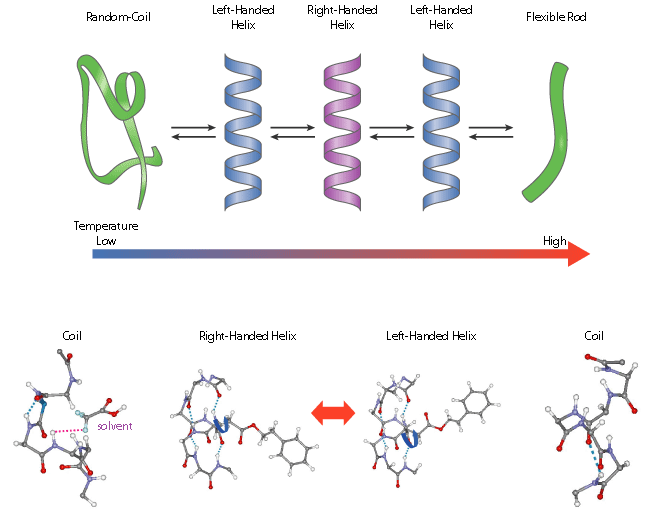
- Elucidation of the mechanism of the main chain hen reversal phenomenon
We precisely synthesized several block co-polymers consisting of a group (aspartate) that causes a reversal of helix sense and a group (glutamate) that do not occur, and nmr and circular bicolicoticity measurements have found that the pseudo-primary transition in molecules with the reversal of the main chain helix begins at one end of the α-helix, and the reassealing of the hydrogen bond hand proceeds by the zipper mechanism.
- Control and molecular design of formation and reassymation of hydrogen bonds in molecules
We are examining the correlation between in-molecule hydrogen bonds and phase transition behavior by precisely synthesizing oligopeptide compounds and using molecular dynamics simulations with methods such as NMR. In addition, we have started an analysis method to quantitatively find hydrogen bond distance information, and are studying dynamics on the formation and reassealing of hydrogen bonds in molecules. In addition, for helix-coil transitions, which are typical secondary structural transitions, oligopeptide compounds consisting of 12 remaining glutamate and 12 remaining alanines are used for 1D and 2D NMR and CD measurements, and quantitative transition mechanisms at the molecular level are elucidated in collaboration with the National Institute of Agricultural and Biological Resources. In addition, the National Institute of Agricultural and Biological Resources conducts three-dimensional structure analysis of peptide molecules with heavy metal detoxification effects.
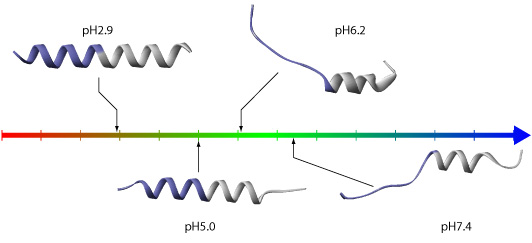
Creation of nanobio-functional response materials
Electrical and optical properties and mechanical properties vary greatly depending on the secondary structure formed by polypeptides. Therefore, we are developing materials that exhibit functional responses by taking advantage of the secondary structure of polyaspartate and its structural transition behavior revealed in previous research.
- Development of stimulus response gel materials
Development of gel materials incorporating polyaspartate molecules into molecular networks is one research theme. Polyaspartate incorporated into the gel network has been shown to show secondary structural transitions as well as bulk solid states. Furthermore, we have found that the sample shape changes greatly in both swollen and solid dry conditions due to secondary structural transitions such as helix-coil transitions and helix inversions.
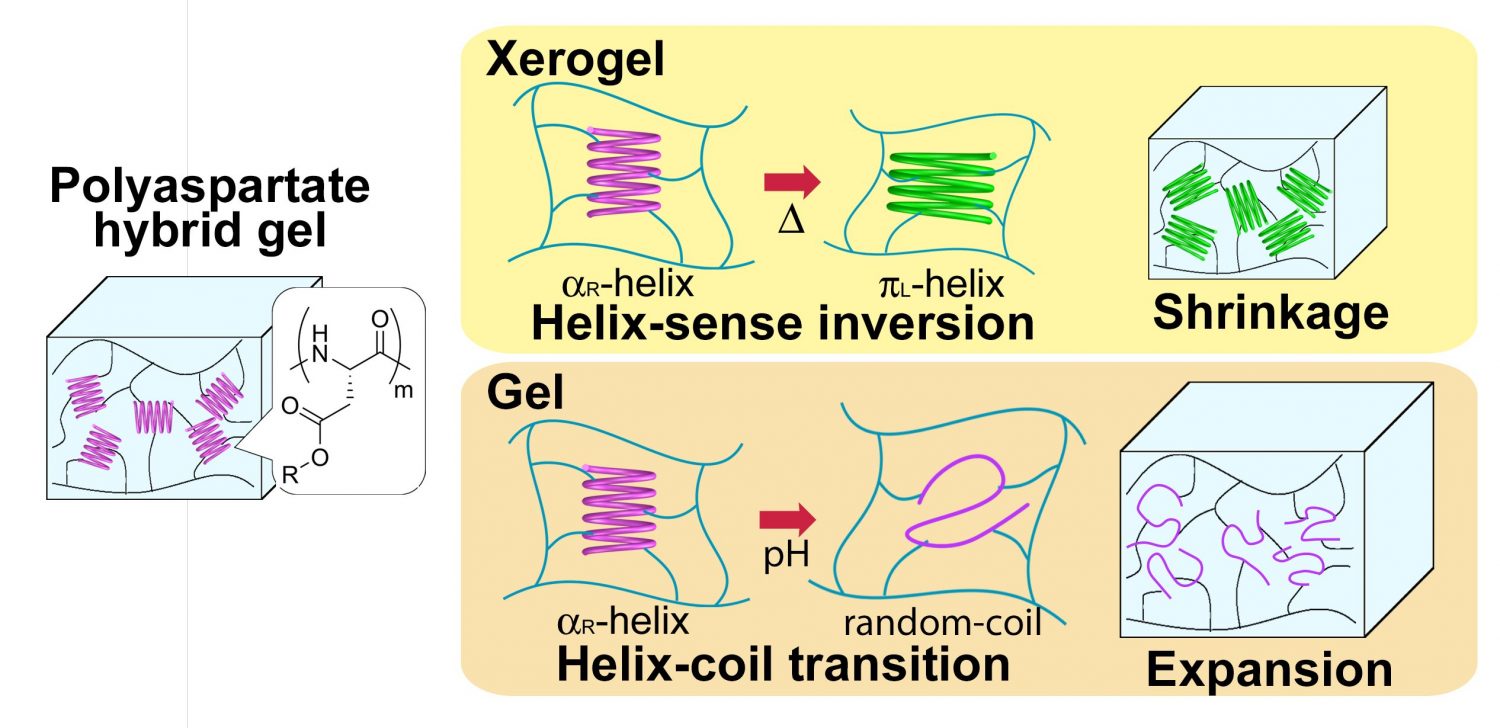
- Research on novel nanodetic devices using grafted peptide thin films
Since the polypeptide that forms the hex structure has a dipolytic moment along the hex axis direction, it is considered that the characteristic properties such as piezoelectricity and nonlinear optical effect are amplified by highly orientation on the substrate. Furthermore, by using polyaspartate, which exhibits henometer inversion behavior, the bipolar moment changes due to the secondary structural transition, so it is expected to construct a new nanobiode device with electrical switch characteristics. Therefore, in order to realize the construction of new nanodetic devices using this property, we are working on research on their orientation structure and electrical properties using peptide thin films grafted on substrates by vacuum deposition heavy law.
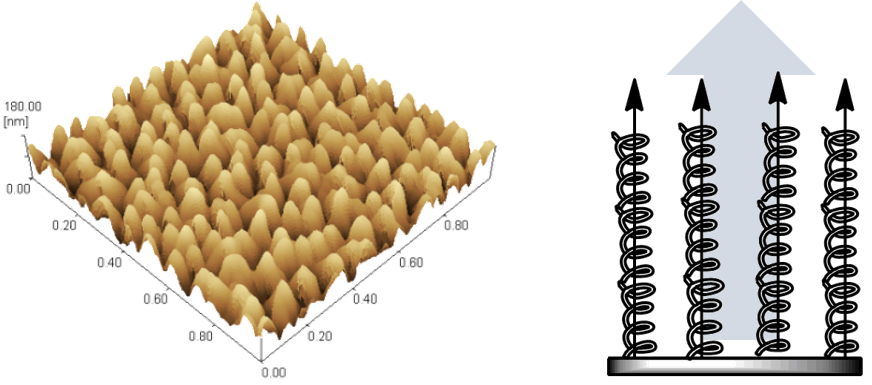
Structural properties and molecular dynamics of amorphous macromolecules
- Local structural analysis of amorphous macromolecules
Knowledge of the structural properties of amorphous states is important for the development of polymeric materials. The amorphous state of atactic polystyrene was determined by molecular dynamics simulation and spin polarization wide angle neutron scattering measurement of partial deuterified samples. For molecular dynamics simulation, we have developed a program using all atomic models and established a method for constructing amorphous states.
- Molecular structure and molecular dynamics of amorphous macromolecules
There is a "fast process" in the picosecond order as a relaxation phenomenon universally observed in glass-forming materials, and there are still many unknown points about the molecular origin. The glass states of polybutadiene, polyisobutylene, methyl polymethacrylate and polystyrene were simulated with molecular dynamics to visualize and clarify the molecular motion mode that is the origin of the "fast process". The simulation results were experimentally verified by measuring quasielastic neutron scattering of partial deuterified samples.
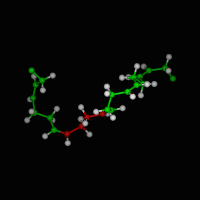
- Cooperative molecular motion of amorphous macromolecules
Molecular dynamics simulations of the molecular mobility of amorphous macromolecules from high temperature to glass transition temperature were applied, and the spatial correlation of relaxation time was evaluated from the analysis of the intermediate scattering function. We showed a picture of dynamics by revealing that a characteristic phenomenon called "deGennes nullowing" was attributed to cooperative molecular motion. We also visualize and clarifie the dynamic heterogeneity of molecular aggregate structures. By combining computational scientific methods called molecular dynamics simulations with experimental methods such as X-ray and neutron scattering measurement, we are conducting research that contributes to the development of molecular levels for high performance and functionalization of polymer material properties.
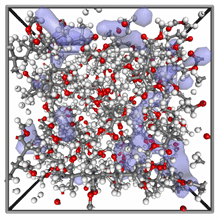
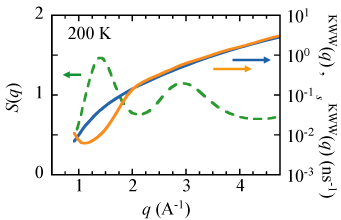
Studies on the structure and materiality of polymer chains in an anthodic field
- Phase transition behavior and conhomation characteristics of main chain polymer liquid crystals
The phase transition behavior of the main chain polymer liquid crystal, which consists of repetitions of liquid crystal-expressing mesogens and flexible spacers, is observed to be odd in the specific thermodynamic amount. By combining deuterum NMR measurement in liquid crystal conditions with rotational isyptic state approximation analysis, we confirmed that it is possible to quantitatively grasp the nematic conhomation peculiar to spacers, established a research method, and clarified the cause of the odd effect. Using the clarified nematic conhomation, we evaluate the experimental values of bipolar moments, an anthomanization of magnetization rates, and optical anthodicity.
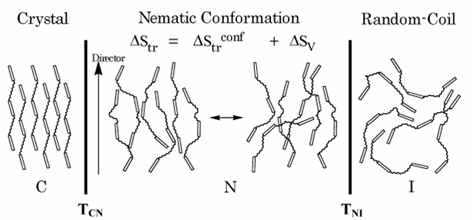
- Molecular study of anthological formation of liquid crystal polymers
By associating thermodynamic changes in the ankymous-isoma phase transition of liquid crystals with molecular-level information such as molecular orientation and molecular conhomation, we have experimentally quantitatively clarified the thermodynamic role of chain molecules in a single-axis ankythodic field. PvT measurements precisely determine transition entropy changes under a certain volume, and quantitatively clarified the contribution of interactions in phase transitions. In order to construct thermodynamic theory of liquid crystal polymers, we are conducting experiments and computer simulations of liquid crystal molecules designed with various molecules.
